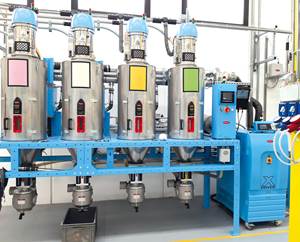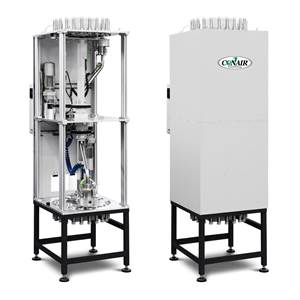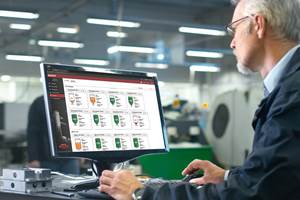Mini Deduster Redesigned, Simplified
Moving parts eliminated, built-in level sensor added.
Conair has simplified operation of its DeDuster C-50 separator, eliminated wear-prone moving parts, and improved processing of regrind, which can be very dusty. The system, which nominally processes up to 50 lb/hr is used to remove lightweight dust, angel hair and streamers from otherwise high-quality pelletized feedstock and regrind being fed to plastics processing machines. If not removed, dust and other lightweight fractions can cause cosmetic problems in molded or extruded products, including haziness, gels and black spots, as well as mechanical flaws and housekeeping problems.
Major design improvements include an adjustable, pneumatically driven vibratory feeder that replaces a paddle-style metering device, which was prone to wear, and which had occasional problems feeding regrind. With the vibratory feeder, regrind flows smoothly and there are no moving parts in contact with the material and, thus, no chance of wear. The feed rate is adjusted via a knob that regulates pneumatic pressure driving the vibrating tray.
Designers also created a wider opening through which solids flow inside of the DeDuster. The previous smaller opening was prone to bridging with regrind particles even as small as ¼ inch. Now, with the larger opening, the DeDuster can typically process regrinds up to 3/8 inch (9.5 mm).
The other enhancement is a built-in level sensor that shuts off the feeder when the hopper below is nearly full. This is important because the DeDuster cannot operate in a flood-feed condition. With the previous generation of the product, users needed to know the precise volume of the hopper and demand of the processing machine and then manually adjust feed rates to prevent over-filling.
The Conair DeDuster C50 commonly achieves residual dust content of fewer than 50 ppm for fines smaller than 500 micron and 100% streamer removal. It is extremely lightweight, weighing just 40 lb and requires only 13.25 in. of additional headroom above the feedthroat of the molding machine or extruder and loading or drying hoppers. It features stainless steel construction, 110 or 220 V operation and only consumes 7 CFM (12 m3/h) compressed air at 90 psi (6.1 bar) pressure.

Once mounted on the processing machine, the unit requires only a single-phase AC power connection and tubing connected to plant compressed air. A simple on/off switch starts the unit and feed rate is set with a rotary knob. Another knob can be used to adjust the desired level of dust removal.
As raw material enters the unit from a standard hopper loader or receiver, the vibratory tray regulates the flow into the dedusting chamber. The compressed air is introduced directly from the plant-air system and split into three streams. The first drives the vibrating table, while a second stream passes through an ionizer before entering the body of the DeDuster where it creates turbulence and breaks the electrostatic bond between pellets and the dust/angel hair. As the heavier, clean pellets continue through the feedthroat into the processing machine, the third air stream passes through a venturi and draws the lighter contaminants into a mini-cyclone so that they fall out of suspension and into a clear catch bin. The air is exhausted through a filtered outlet.
Related Content
Finding Efficiencies in How Components Work Together
Auxiliary systems are vital to the proper functioning of a plastic processing line, and they can be a source of major cost and efficiency improvements.
Read MoreWisconsin Firms Unite in Battle Against Covid
Teel Plastics opened new plant in record time, partnering with AEC & Aqua Poly Equipment Co. to expand production of swab sticks to fight pandemic.
Read MoreResin-Selection Station Conveys Material on Demand
NPE2024: Powerful, space- and labor-saving station makes the connections and conveys material automatically on command.
Read MoreSingle View of Bin & Silo Material Levels in Multiple Locations
Got a bin in Buffalo and a silo in San José? BinMaster’s latest addition to its cloud inventory software lets you see all your resin inventory anywhere in one view.
Read MoreRead Next
Understanding Melting in Single-Screw Extruders
You can better visualize the melting process by “flipping” the observation point so that the barrel appears to be turning clockwise around a stationary screw.
Read MoreAdvanced Recycling: Beyond Pyrolysis
Consumer-product brand owners increasingly see advanced chemical recycling as a necessary complement to mechanical recycling if they are to meet ambitious goals for a circular economy in the next decade. Dozens of technology providers are developing new technologies to overcome the limitations of existing pyrolysis methods and to commercialize various alternative approaches to chemical recycling of plastics.
Read More









